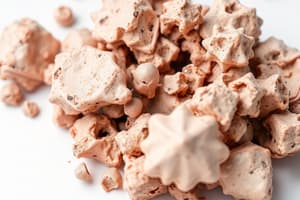Podcast
Questions and Answers
Which type of property is directly proportional to the amount of matter in a substance?
Which type of property is directly proportional to the amount of matter in a substance?
- Extensive property (correct)
- Physical property
- Intensive property
- Measurable property
What is an example of an extensive property?
What is an example of an extensive property?
- Volume
- Temperature
- Density
- Mass (correct)
Which property remains constant regardless of the amount of matter in a substance?
Which property remains constant regardless of the amount of matter in a substance?
- Mass
- Density (correct)
- Energy
- Volume
If you combine two identical objects, which property will be additive according to the text?
If you combine two identical objects, which property will be additive according to the text?
Which type of property is affected by the size or mass of the sample?
Which type of property is affected by the size or mass of the sample?
What is the unit for volume when measuring a substance's space occupied?
What is the unit for volume when measuring a substance's space occupied?
Which type of property does not change when the amount of a substance is altered?
Which type of property does not change when the amount of a substance is altered?
What property involves the resistance to scratching or indentation?
What property involves the resistance to scratching or indentation?
Which property is related to relationships between the components or behavior of a substance?
Which property is related to relationships between the components or behavior of a substance?
If you double the volume of a gas and its pressure remains the same, what type of property is pressure?
If you double the volume of a gas and its pressure remains the same, what type of property is pressure?
What is the measure of the maximum reversible work that can be done by a system at constant temperature and pressure?
What is the measure of the maximum reversible work that can be done by a system at constant temperature and pressure?
Which property can be observed without altering a substance's chemical composition?
Which property can be observed without altering a substance's chemical composition?
Study Notes
Understanding Matter Properties
The world around us is composed of matter in various forms, from solid gold to gaseous oxygen. Matter's properties enable us to identify, categorize, and interact with it. To better understand and analyze matter, scientists have classified its characteristics into two main groups: extensive and intensive properties.
Extensive Properties
Extensive properties are those that are directly proportional to the amount of matter in a substance. They increase in direct proportion to the mass of the substance. Some examples of extensive properties include:
- Mass: The amount of matter in an object, calculated in kilograms (kg) or grams (g).
- Volume: The amount of space occupied by a substance, measured in cubic meters (m³) or cubic centimeters (cm³).
- Number of particles: The total count of atoms, molecules, or ions in a substance.
- Energy: The amount of stored or kinetic energy in a substance, usually measured in joules (J).
Extensive properties are additive; for example, if you combine two identical objects, their total mass, volume, and energy will be the sum of the individual values.
Intensive Properties
Intensive properties, on the other hand, do not change with an increase in the amount of matter. They are not affected by the size or mass of the sample. Some examples of intensive properties include:
- Density: The mass of a substance per unit volume, calculated in kg/m³ or g/cm³.
- Temperature: The degree of hotness or coldness of a substance, measured in Kelvin (K) or Celsius (°C).
- Pressure: The force exerted per unit area by a substance, measured in pascals (Pa) or atmospheres (atm).
- Melting point: The temperature at which a solid substance turns into a liquid.
- Boiling point: The temperature at which a liquid substance turns into a gas.
Intensive properties do not change when a substance's amount is altered. For example, if you double the volume of a gas, its pressure will also double, but the gas will still have the same density.
Physical Properties
Physical properties are those that can be measured and observed without altering a substance's chemical composition. They include both extensive and intensive properties. Some examples of physical properties include:
- Color: The appearance of a substance.
- Odor: The scent of a substance.
- Hardness: The resistance to scratching or indentation.
- Conductivity: The ability of a substance to conduct electricity or heat.
- Solubility: The ability of a substance to dissolve in a solvent.
Measurable Properties
Some properties are measurable but not necessarily physical. They involve relationships between the components or behavior of a substance. For example:
- Stoichiometry: The relationship between the mole ratio of reactants and products in a chemical reaction.
- Enthalpy: The heat absorbed or released by a substance during a chemical or physical process.
- Gibbs free energy: A measure of the maximum reversible work that can be done by a system at constant temperature and pressure.
Measurable properties are particularly important in understanding chemical reactions and the behavior of matter under various conditions.
In summary, understanding the properties of matter is essential for classifying, analyzing, and predicting the behavior of substances. Extensive properties increase with the amount of matter, intensive properties do not, and both physical and measurable properties are observable and measurable characteristics of matter. With this knowledge, scientists can better understand and manipulate the world around us.
Studying That Suits You
Use AI to generate personalized quizzes and flashcards to suit your learning preferences.
Description
Explore the characteristics of matter through extensive and intensive properties. Learn how extensive properties change with the amount of matter, while intensive properties remain constant. Dive into physical properties and measurable properties to gain insights into the behavior of substances.




